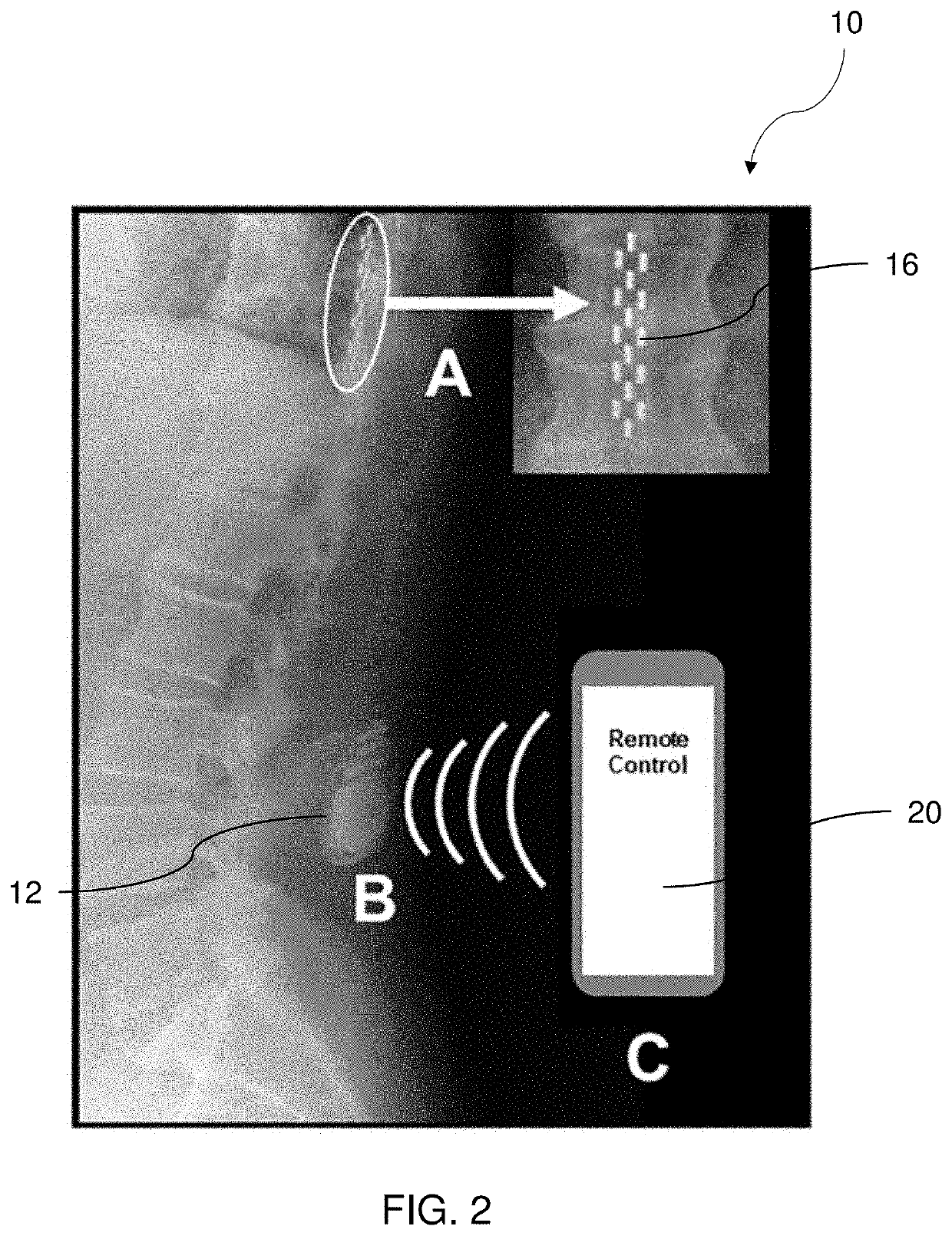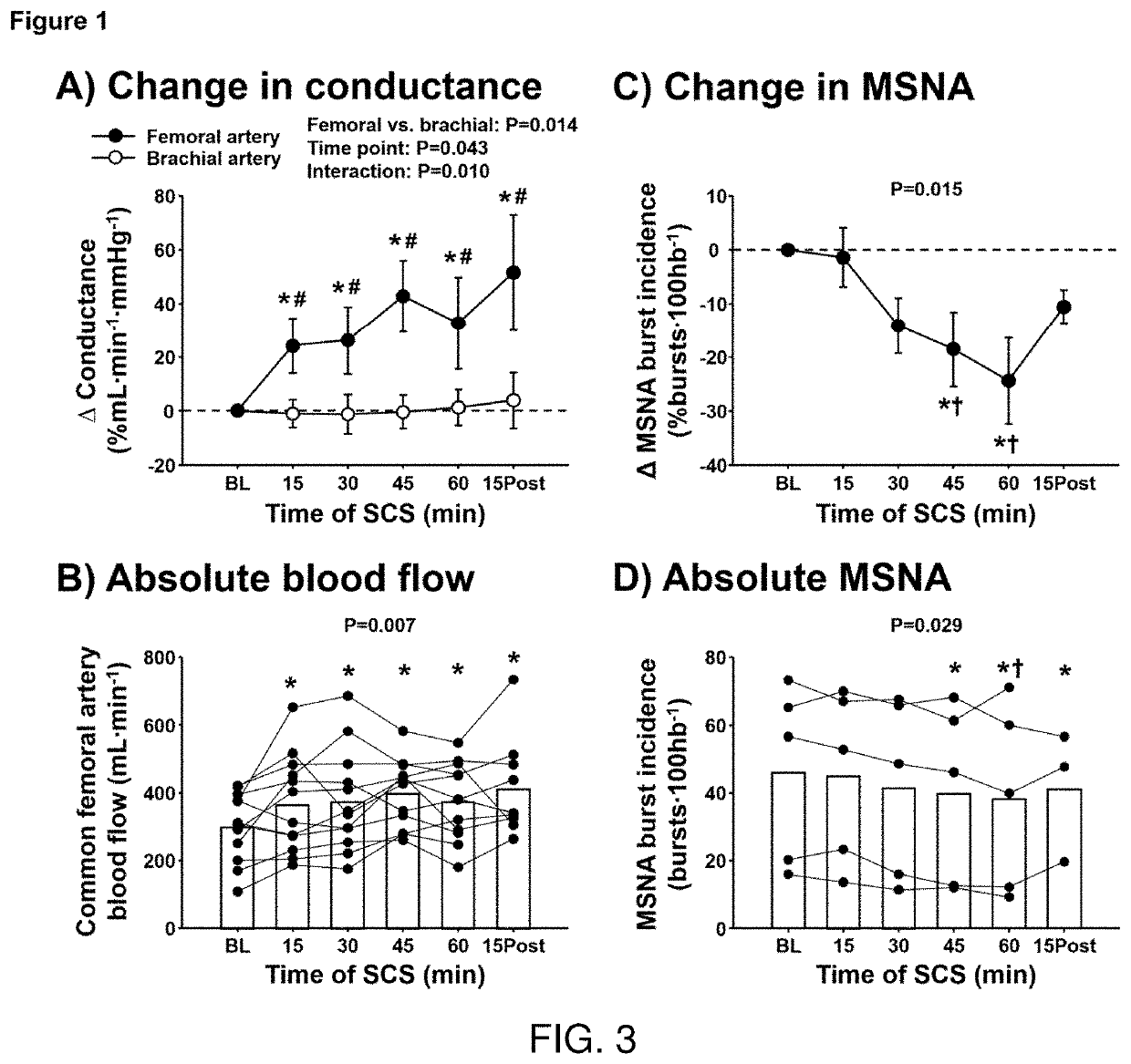Systems, devices and methods for treatment using spinal cord stimulation by selectively reducing the activity of the sympathetic nervous system 18039
a technology of spinal cord stimulation and sympathetic nervous system, which is applied in the field of spinal cord stimulation, can solve the problems of increased risk of additional medical problems, patients in otherwise compromised physical states, and inability to have a normal wound healing response, so as to reduce muscle sympathetic nerve activity and increase femoral vascular conductance
- Summary
- Abstract
- Description
- Claims
- Application Information
AI Technical Summary
Benefits of technology
Problems solved by technology
Method used
Image
Examples
experimental examples
[0038]The following examples are put forth so as to provide those of ordinary skill in the art with a complete disclosure and description of how the articles, devices and / or methods claimed herein are made and evaluated, and are intended to be purely exemplary of the invention and are not intended to limit the scope of what the inventors regard as their invention. However, those of skill in the art should, in light of the present disclosure, appreciate that many changes can be made in the specific embodiments which are disclosed and still obtain a like or similar result without departing from the spirit and scope of the invention.
[0039]Example 1 tested the hypothesis that acute SCS (<60 min) of the thoracic spine would lead to increased common femoral vascular conductance, but not brachial vascular conductance, in 12 patients that previously underwent surgical SCS implantation (2.5±1.3 years) for management of neuropathic pain. During SCS, common femoral artery conductance was eleva...
example 1
Conductance
[0057]Vascular conductance responses to acute SCS. The change in femoral vascular conductance was significantly elevated and greater than brachial vascular conductance at 15-, 30-, 45-, and 60-min of SCS, and 15-min post SCS (Artery×time point interaction: P=0.010) (FIG. 3A). Despite the absence of stimulation at 15 min post SCS, femoral vascular conductance remained elevated compared to brachial vascular conductance. Femoral artery blood flow was elevated and significantly increased at 30- and 45-min (P=0.016) (FIG. 3B). No changes in end-diastolic femoral artery diameter were detected during SCS (BL: 7.9±1.9, 15 min: 7.9±1.9, 30 min: 7.8±2, 45 min: 8±1.8, 60 min: 8.1±1.8 mm, P=0.215). Blood flow after 60 min of SCS (15 min post-SCS) was not able to be collected on patients 2, 4 and 5 because of the inability to remain rested in the supine position.
[0058]Cardiovascular responses to acute SCS. No changes in HR were observed throughout SCS (BL: 60±6, 15 min: 59±7, 30 min: ...
example 2
mpathetic Nerve Activity (MSNA)
[0059]Influence of acute SCS on muscle sympathetic nerve activity: MSNA during SCS gradually declined and became significantly reduced at 45- and 60-min of SCS compared with baseline and 15 min (P=0.015) (FIG. 3C). Similar results were observed for the change in MSNA burst frequency (15 min: Δ−1±6%, 30 min: Δ−13±4%, 45 min: Δ−17±6%, 60 min: Δ−21±7%, 15 min post: Δ−4±5% bursts / min, P=0.027). Absolute values of MSNA burst incidence were significantly reduced compared to baseline at 45- and 60-min of SCS, and remained attenuated 15 min post-SCS (FIG. 3D).
[0060]Individual MSNA recordings showing burst incidence and total activity during SCS from 3 patients are presented in FIG. 4. MSNA recording did not continue after 60 min of SCS (15 min post-SCS) in patients 4 because of the inability to remain in the fixed position required to maintain the MSNA recording. However, an end-expiratory breath hold was performed by patient 4 immediately following the cessat...
PUM
 Login to View More
Login to View More Abstract
Description
Claims
Application Information
 Login to View More
Login to View More - R&D
- Intellectual Property
- Life Sciences
- Materials
- Tech Scout
- Unparalleled Data Quality
- Higher Quality Content
- 60% Fewer Hallucinations
Browse by: Latest US Patents, China's latest patents, Technical Efficacy Thesaurus, Application Domain, Technology Topic, Popular Technical Reports.
© 2025 PatSnap. All rights reserved.Legal|Privacy policy|Modern Slavery Act Transparency Statement|Sitemap|About US| Contact US: help@patsnap.com



